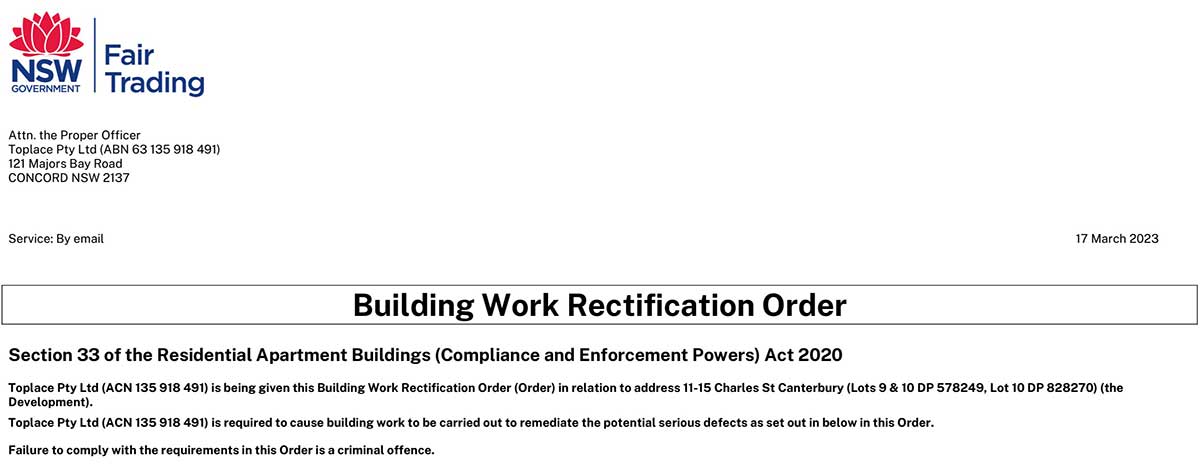Two years ago, we commented on the potential impact the introduction of the Design & Building Practitioners Act (D&BP Act) on the property development industry.
This legislation was a response to the Shergold and Wier report commissioned by the Building Minister’s forum. This group consisted of federal, state and territory ministers. The report highlighted deficiencies in compliance with building codes and poor construction practices primarily related to high rise towers. This followed the widely reported Grenfell & Lacrosse tower façade fires in London & Melbourne, and the structural failure of the Opal & Mascot Towers in Sydney.
Historically, it was common practise for many property developers to procure buildings using a design and construct model. Typically, this limited the extent of documentation prepared by the developer’s design consultants to the minimum necessary to obtain BA approval. In turn, reducing their upfront consultant fee obligations payable before construction finance was in place.
The design consultants’ services would then be novated to the builder who would take control of the ongoing design & documentation process. Often this resulted in implementing value management reviews with the intent of finding cost savings to reduce the construction costs or increase profits.
In most cases, this procurement model delivered well-built unit developments that achieved the objectives of both the developer and the end user.
Unfortunately, there are always exceptions to the rule.

Investigations Into Structural Issues
Recently, Fairwork NSW have been investigating numerous structural issues discovered in projects undertaken by one of Sydney’s largest residential property developers – Toplace.
This developer employed many of the key design consultants in-house. This meant they were exercising total control over of the entire design, construction, and approval process.
One of Toplace’s current projects, the Vicinity complex, has been identified as being at risk of collapse requiring repairs costing up to $50 million.
This company has since gone into administration owing hundreds of millions of dollars. In addition, the developer has fled the country. More than 20,000 homeowners across twenty buildings could be impacted by the collapse of this company.
All consultants and builders involved in Class 2 building design and construction must now apply to Fairwork NSW to be registered as a design practitioner or builder.
Mandated Documentation
The extent of documentation required to be provided by design practitioners is now mandated for each discipline. Each consultant must complete a design compliance declaration stating the documentation is fully compliant with all regulations, and standards required by the Building Code of Australia. This effectively transfers liability to the design practitioner for any non-compliance issues that may be identified during or after construction.
This onerous new documentation regime requires developers undertaking even low to medium rise residential projects to engage additional specialist consultants. Some of these were previously unknown or not considered necessary for residential projects.
Fairwork NSW employ teams of building compliance auditors who thoroughly examine the construction documentation prepared by the registered design practitioner for all multi residential projects. Spot audits are then conducted of construction sites to ensure the builders and developers are complying fully with those documents.
The Process of Obtaining Building Approval
Obtaining building approval for these projects is no longer the straightforward process it was in the past. Previously, limited documentation would often suffice, allowing more detailed tender or construction documentation to be prepared subsequently. Comprehensive construction documentation is now required in order to obtain a BA.
The building certifier must then examine every regulated design document thoroughly. This is to ensure compliance with all relevant regulations including the specific provisions of the D&BP Act, before granting building approval.
Since the principal certifier must remain autonomous, it is now prudent practice for developers to engage an independent building certifier to provide compliance advice. This is done with the design team during the design and documentation process, whilst the principal certifier is responsible for certification services granting building and occupation approvals.
Certifiers must be extra vigilant during construction. Inspecting every component to ensure 100% compliance with the approved documentation is a must. Allowances for minor dimensional discrepancies related to construction tolerances that may have been reasonably overlooked in the past are now considered defects. These discrepancies now require rectification before a project is deemed complete.
Fairwork NSW also hold a bond from the developer that isn’t released until a final audit is undertaken confirming the project has been constructed satisfactorily. In addition to holding the design practitioners to account, they are also effectively auditing both the builder and certifier.
Noncompliance or Poor Performance
Noncompliance or poor performance, by any consultant or builder, on a regulated design project is recorded on a register by Fairwork NSW identifying them for future monitoring, or possible blacklisting.
These new regulations governing projects undertaken in NSW have significantly increasing the liabilities, costs, and time now required to design and document new multi-residential units.
Many in the industry believe this new level of compliance is akin to using a sledgehammer to crack a peanut, and consequently new multi-residential building approvals in NSW have slumped significantly.
Similarly, many consultants and builders unwilling or unable to take on these onerous additional liabilities are no longer undertaking work on Class 2 projects. This further exacerbates the current housing supply and affordability crisis.
It’s anticipated that other States throughout Australia will be implementing similar measures in the future. So, be prepared for further disruptions and delays to the production of new housing stock around the country.
LDS have recently undertaken several medium rise residential projects in NSW since this legislation was enacted. Whilst it has been a very steep learning curve, we now have a comprehensive understanding of the level of design, documentation and co-ordination required to navigate this minefield to achieve compliance with the D&BP Act.
You might also be interested in...
The Most Popular Home Configurations in Australia in 2024
Discover 2024’s top Australian home configurations: bedrooms, bathrooms, and parking preferences. Explore how changing lifestyles shape popular house configurations nationwide.
Exploring Contemporary Applications of Brise Soleil
Contemporary applications of Brise Soleil combine functionality, aesthetics, and sustainability, making them a popular choice in various building designs worldwide.
